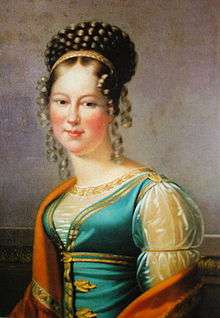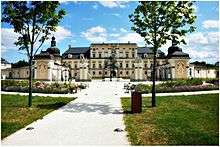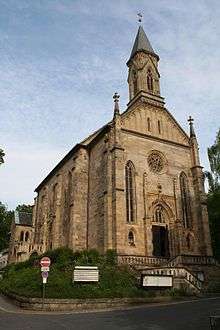House of Saxe-Coburg and Gotha-Koháry
| House of Saxe-Coburg-Gotha-Koháry | |
|---|---|
| Country |
Habsburg Empire Kingdom of Portugal Kingdom of Bulgaria Empire of Brazil |
| Parent house |
House of Saxe-Coburg and Gotha (male line) House of Koháry (female line) |
| Titles |
Prince of Saxe-Coburg and Gotha King of Portugal and the Algarves (1837–1910) Prince of Bulgaria (1887–1908) Tsar of Bulgaria (1908–1946) |
| Founded | 1826 |
| Founder |
Prince Ferdinand and Princess Maria Antonia |
| Final ruler | Prince Philipp; no family head since abolition of fideicommiss |
| Dissolution | 1938 |
| Ethnicity | Germans, Austrians, Hungarians |
| Cadet branches |
Braganza-Saxe-Coburg-Gotha Bulgarian Royal Family |
The House of Saxe-Coburg-Gotha-Koháry is the Catholic cadet branch of the House of Saxe-Coburg and Gotha. It was founded after the marriage of Prince Ferdinand of Saxe-Coburg and Gotha with Princess Maria Antonia Koháry de Csábrág. Among its descendants are the last three kings of Portugal (Luis I, Carlos I, Manuel II), and the last three Tsars of Bulgaria (Ferdinand I, Boris III, Simeon II).
History
After the marriage of Prince Ferdinand of Saxe-Coburg and Gotha with Princess Maria Antonia Koháry de Csábrág in January 1816[1] and the death of his father-in-law, Prince Ferencz József Koháry de Csábrág, in 1826, Prince Ferdinand inherited the Hungarian princely estate of Koháry and converted to Roman Catholicism. The descendants of his branch managed to marry an imperial princess of Brazil, an archduchess of Austria, a royal princess of "the French", a royal princess of Belgium and a royal princess of Saxony. A scion of this branch, also named Ferdinand, became Prince, and then Tsar, of Bulgaria, and his descendants continued to rule there until 1946. The current head of the House of Bulgaria, the former Tsar Simeon II who was deposed and exiled after World War II, goes by the name Simeon Sakskoburggotski and served as Bulgaria's prime minister from 2001 to 2005.
Ferdinand and Antonia had four children, all of whom were raised Catholic:
- Ferdinand II of Portugal (1816–1885), was the husband of Queen Maria II of Portugal.
- August (1818–1881), was the father of Ferdinand I of Bulgaria.
- Victoria (1822–1857), married Louis, Duke of Nemours.
- Leopold (1824–1884).
 Princess Maria Antonia Koháry(1797–1862)
Princess Maria Antonia Koháry(1797–1862) Prince Ferdinand of Saxe-Coburg and Gotha (1785–1851)
Prince Ferdinand of Saxe-Coburg and Gotha (1785–1851) Ferdinand of Portugal, Prince August and Princess Victoria with a bust of their father Prince Ferdinand of Saxe-Coburg and Gotha
Ferdinand of Portugal, Prince August and Princess Victoria with a bust of their father Prince Ferdinand of Saxe-Coburg and Gotha
Branches
House of Braganza-Saxe-Coburg and Gotha
The royal House of Braganza-Saxe-Coburg and Gotha is a cadet branch of the House of Saxe-Coburg-Gotha-Koháry. This royal house was founded by Prince Ferdinand, who on 9 April 1836 married Queen Maria II of Portugal from the House of Braganza.
Ducal branch
After the death of his father in law, Franz Joseph Koháry, Prince Ferdinand of Saxe-Coburg and Gotha reorganised the family fortune in two Fideicommisses and adopted the title Duke for him and his successors as Fideikommissherr.[2] After his death 1851 and that of his wife Maria Antonia Koháry 1862, Prince August became head of the family. The oldest son, Ferdinand, had to renonunce when he married Queen Mary of Portugal.[3] After August his oldest son Prince Philipp of Saxe-Coburg and Gotha (1844–1921), became head of the family. Philipps only son died before him, so his grandnephew Prince Philipp of Saxe-Coburg and Gotha (1901-1985) inherited the fortune 1921.[4] 1938 the Family Fideikommisses were abolished.
 Prince August of Saxe-Coburg and Gotha (1818–1881)
Prince August of Saxe-Coburg and Gotha (1818–1881) Prince Philipp of Saxe-Coburg and Gotha (1844–1921), became head of the family after the death of his father Prince August.
Prince Philipp of Saxe-Coburg and Gotha (1844–1921), became head of the family after the death of his father Prince August.- The children of Prince August of Saxe-Coburg and Gotha
Brazilian line
Prince Ludwig August was the second son of Prince August of Saxe-Coburg and Gotha and Clémentine of Orléans. On 15 December 1864, he was married in Rio de Janeiro to Princess Leopoldina of Brazil. After the fall of the Brazilian Empire 1889, the family returned to Europe. Prince Philipp, who became head of the house in 1921, was a grandson of Prince Ludwig August.
Bulgarian branch
Ferdinand I of Bulgaria was the youngest son of Prince August of Saxe-Coburg and Gotha and Clémentine of Orléans. In 1887, he became the ruler of Bulgaria. The current Bulgarian royal family descends from him.
 Ferdinand I (1861–1948
Ferdinand I (1861–1948 Boris III of Bulgaria (1894–1943)
Boris III of Bulgaria (1894–1943) Simeon II (*1937)
Simeon II (*1937)
Properties and Palaces
Fideicommiss
Princess Maria Antonia Koháry inherited over 150000 hectares of land in Lower Austria, Hungary and Slovakia, including estates, forests, mines and factories. According to a list of assets appended to the marriage contract of her son, Prince August, at the time of his marriage to Princess Clémentine of Orléans in 1843, the Koháry properties included the enormous Palais Koháry in the center of Vienna and several Viennese manors, a summer home and lands at Ebenthal, Lower Austria, estates in Austria at Velm, Durnkrut, Walterskirchen, Bohmischdrut and Althoflein, as well as a dozen manors in Hungary, the domaine of Kiralytia, and a mansion at Pest.[5] As late as 1868, when Antónia's grandson Prince Ferdinand, Duke of Alencon, married, it was estimated that he and his three siblings stood to inherit a total of a million francs just from their share of their late grandmother's estate.[5]
After the death of his father in law, Franz Joseph Koháry, Prince Ferdinand of Saxe-Coburg and Gotha reorganised the family fortune in two Fideicommisses and adopted the title Duke for him and his successors as Fideikommissherr.[2] Until the first world war, her descendants, the Koháry branch of the House of Saxe-Coburg and Gotha, were among the three largest landowners in Hungary.
- Prinz Ferdinand Coburgsches Fideikommiss
- Gräflich Kohárysches Fideikomiss
The two fideicommisses allowed to hold the family property in foundations owned by the whole family, but governed by the head of the family alone, the Fideicommissherr. Aristocratic families had used this instrument to finance the representative household of the head of the family as well as to maintain palaces and castles, and to pay allowances to family members without personal wealth. Fideikommisses were abolished in Austria after the Anschluss 1938.
Palaces
- Palais Coburg Vienna, today a Hotel.
- Palace of Svätý Anton in Slovakia, today a museum.
 Ebenthal, Lower Austria, today private property
Ebenthal, Lower Austria, today private property Walterskirchen castle near Poysdorf, Lower Austria is still owned by the family.
Walterskirchen castle near Poysdorf, Lower Austria is still owned by the family. Dürnkrut, Austria, today the city hall of the municipality.
Dürnkrut, Austria, today the city hall of the municipality. Edelény Palace, acquired 1831, today owned by the Hungarian state.
Edelény Palace, acquired 1831, today owned by the Hungarian state. Coburg castle, Schladming, built 1885 for Prince Ludwig August of Saxe-Coburg and Gotha, today the city hall of the municipality.
Coburg castle, Schladming, built 1885 for Prince Ludwig August of Saxe-Coburg and Gotha, today the city hall of the municipality. Vrana Palace in Sofia, Bulgaria, built in the beginning of 20th century, it is now owned by the former monarch Simeon II and his family
Vrana Palace in Sofia, Bulgaria, built in the beginning of 20th century, it is now owned by the former monarch Simeon II and his family Palace of Euxinograd on the northern Black Sea coast of Bulgaria. Build between 1881-1885 as a summer residence of Ferdinand I of Bulgaria, today the palace is owned by the Bulgarian state.
Palace of Euxinograd on the northern Black Sea coast of Bulgaria. Build between 1881-1885 as a summer residence of Ferdinand I of Bulgaria, today the palace is owned by the Bulgarian state.
Burial site
In 1851, a committee headed by Prince August of Saxe-Coburg and Gotha set out to plan the construction of a Roman Catholic church in Coburg with a burial vault underneath. St. Augustin was opened on 28 August 1860. The crypt contains the remains of fifteen members of the Koháry branch of the House of Saxe-Coburg.
 St. Augustin in Coburg
St. Augustin in Coburg- Prince August and his wife, Princess Clémentine of Orléans, are buried in a double sarcophagus, the remains of their youngest son, Tsar Ferdinand of Bulgaria, were placed at their feet.
- Sarcophagus of Peter August von Sachsen-Coburg und Gotha (1866–1934)
Footnotes
- ↑ http://www.kuk-wehrmacht.de/biograph/b0003scsk.html
- 1 2 August Wilpert, Bayerische Bibliographie .Kurze Geschichte der katholischen, sog. "Koháry"-Linie des Herzoglichen Hauses Sachsen-Coburg und Gotha, http://gateway-bayern.de/BV014584282 Page 4
- ↑ https://www.deutsche-digitale-bibliothek.de/item/3YXRN32VPUYFVRDXFMVAJQO6PUFLC2QL
- ↑ Josef Tafler, Rudolf Eisler: Mitteilungen aus dem Publikum. (…) Erklärung. In: Neue Freie Presse, 22. February 1925, p. 10 (Online at ANNO)
- 1 2 Paoli, Dominique (2006). Fortunes & Infortunes des Princes d'Orléans. France: Editions Artena. pp. 107, 113, 372. ISBN 2-35154-004-2.
External links
-
 Media related to House of Saxe-Coburg-Kohary at Wikimedia Commons
Media related to House of Saxe-Coburg-Kohary at Wikimedia Commons - Saxe-Coburg-Koháry exposition in the Manor House Svätý Anton